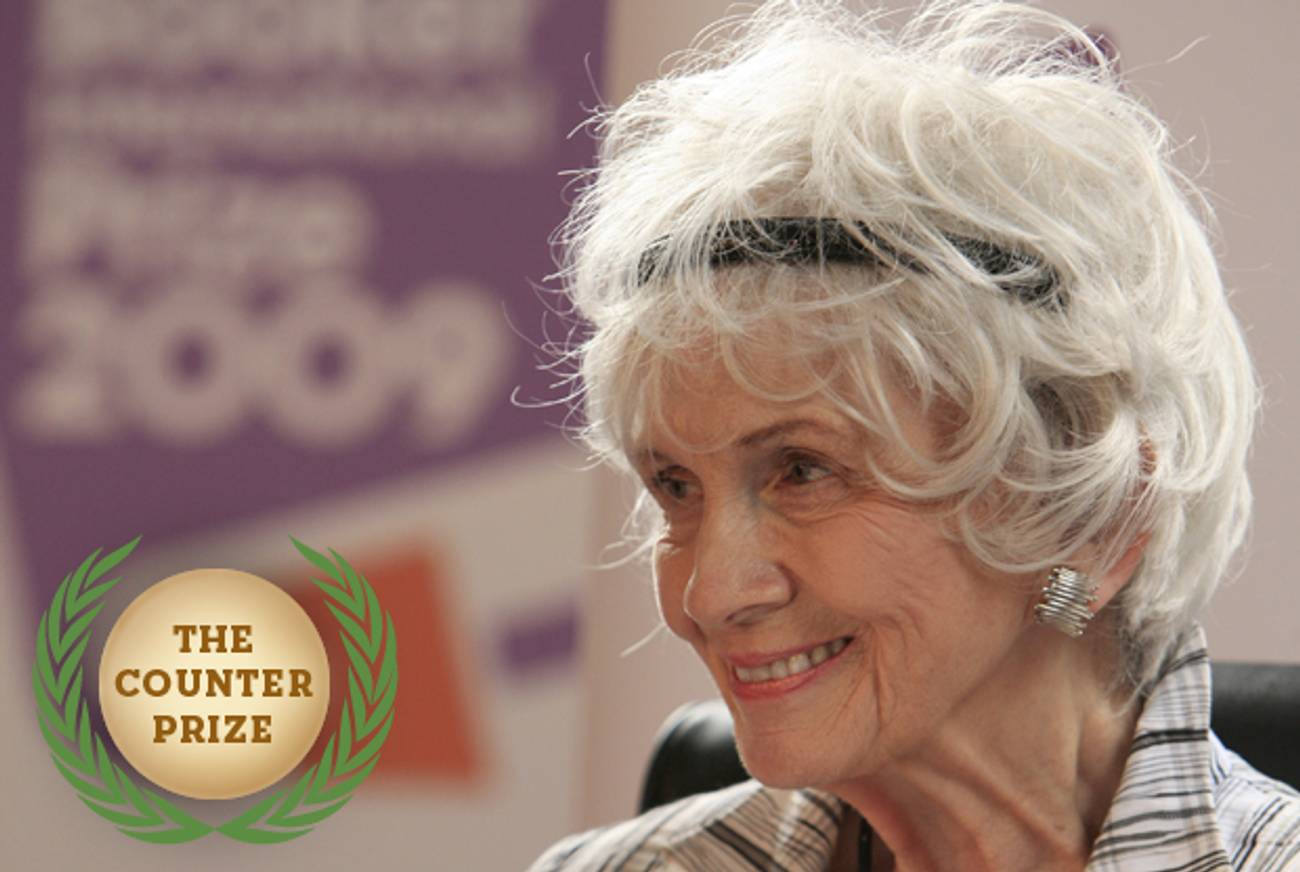Another Year, Another Man
The prize should have gone to Atwood or Lahiri—or, better yet, Munro




For full coverage of Philip Roth’s Nobel Prize, please click here.
We shouldn’t be surprised that macho, phallocentric writer Philip Roth has taken home the Nobel Prize in Literature. After all, the literary fiction scene is both macho and phallocentric, suffering from “Great Man Syndrome,” as Jenny McPhee put it at Bookslut earlier this month. “In an individual,” McPhee wrote, “the syndrome presents itself predominantly in high-achieving males as the conviction that they are fundamentally central to human existence, sovereign agents of history. In the aggregate, the illness manifests in the mass delusion that certain male individuals by the sheer force of their achievements are alone responsible for determining our collective destiny.”
And now the King of the Great Man Syndrome has been awarded the Great Man Prize, the $1.2 million phallus to end all phalli: the Nobel Dildo, awarded yearly to the biggest penis on the scene. Considering the results of the 2012 VIDA report showing the ratio of female-to-male book reviews and book reviewers in the capital-I-important publications, we shouldn’t be surprised at all. Harper’s, for instance, reviewed all of 11 works of fiction by women in the year 2012. Which is why it’s not surprising that some of the true masters of the craft, rather than of penis-gazing self-obsession, have been passed over yet again. Sure, there are Pearl Buck and Nelly Sachs and Elfriede Jelinek and a few others. They total a meager 12. Surely there is a deserving 13th woman alive. Hilary Mantel, anybody? Margaret Atwood? Or—best of all—Alice Munro?
Indeed, Munro would have been perfect. Even obvious. The accidental writer and accidental genius, boss of the short story, master of language, a woman who has written quietly in Canada for the past 60 years reporting on without ever purporting to solve the mysteries of the human condition? Alice Munro has taught us what a short story is. But she also taught us how to appreciate a mystery, how to interpret failure, wherein lies the music of the unresolved.
There is a quality to the language in her stories that has a transformative effect, on the reader and on the English language, especially with the ravishing accuracy of her strings of adjectives. An old lady in a nursing home is “crafty and disagreeable.” A 12-year-old girl is “puritanical and outrageous.” Young husbands are “resolute and disapproving,” their wives “dreamily rebellious” in a second adolescence. Of a Christian at a dinner party observing an argument: “What did it matter who won? For Kimberly, all the arguments have already been won.” Of a woman claiming to know how her ex-husband felt now that she has experienced the scorn of her current lover, her friend says, “I doubt if things are so symmetrical.” Indeed.
Simply put, Munro writes short stories about women, not long stories about penises. For example, among Munro’s earlier stories, there is one about two little girls who forge love letters from one girl’s father to her nanny; the nanny’s world and the young girls’ world are revealed to be one and the same, ontologically speaking, through the image of the forged letter. Many stories tell the tale of young women from semi-literate families who fall in with a literate and abusive man. Many stories are about middle-aged women dealing with a loss of attractiveness that leads to a knowledge about sex, or to better sex. Many stories are about middle-aged women who realize something about youth and also how contingent this realization is. Stories about mothers who put themselves before their children and the children are OK. Stories about sick old ladies with secrets they reveal to their nurses in order to keep their husbands. Women scorned in love, women scorning in love. A woman falls in love with another woman’s sometime-lover; the two women become close friends, but the sometime-lover “will never forgo the ironic flicker of submerged rivalry.”
This is Munro at her best, identifying life’s mysteries and drawing them as curiosities that one might find in a variety show. But these images don’t at all dispel the mystery of being human. They rather alert the reader to the mystery, the idea of an alluring unknown to which we are held captive. “Yes, that’s exactly it!” I often want to say, “But why is it so?” Munro’s magic consists in not answering this question at all.
As Jonathan Franzen once wrote in the New York Times, Munro doesn’t write books called The Plot Against Canada, and for this reason, Franzen argues, “her excellence so dismayingly exceeds her fame.” Instead of Roth’s self-important statement upon winning the prize, we might have gotten some stirring statement full of humility and yet somehow devoid of pretentious self-effacement. We can imagine the letter being full of hope that these communities would be raised up along with the Nobel prizewinner, a letter that made the achievement seem like a blessing for a community, rather than a prize for an individual.
Batya Ungar-Sargon is a freelance writer who lives in New York. Her Twitter feed is @bungarsargon.